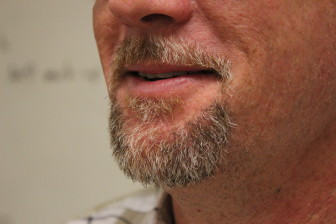

Around Aragon, certain teachers have become famous for their interesting takes on facial hair. With his well-kept, distinctly full beard, Physics teacher Steve Ratto is one example.
Ratto says, “My friend had this New Year’s party a couple years ago, and it was a really fancy event, so I shaved completely. After that, I wanted to see how a beard felt, and I grew it out to see if I liked it. I did, so I’ve kept it ever since.”
The past few years have seen an increasingly popular trend in facial hair styles. For Ratto, facial hair is a way men can add a customization to their everyday look.
“I think a lot of men are using their beards to get a personal touch with the look. I also think that since you don’t really have a chance to have facial hair when you’re younger, a lot of people are trying to grow out their facial hair when they’re older to see how it feels, and they’re realizing that it’s not that bad, and they want to keep their beard or mustache or whatever facial hair they have.”
For Drama teacher Shane Smuin, his Van Dyke beard, consisting of a moustache and a goatee, was more of an artistic choice. Says Smuin, “I grew out my hair because we are doing a Shakespeare play, and I wanted to get in the Shakespeare’s zone. Shakespearean actors and directors had facial hair, and Shakespeare himself had a little facial hair too, I think.”
In the true spirit of hipster culture, old-fashioned facial trends, like the handlebar mustache or Van Dyke, are now getting a modern twist and are often paired with a full beard or styled a little more subtly where it turns up.
Senior Trina Johnson remarks, “I think the saying ‘Everything old is new again’ can account for this revival of fashionable facial hair.”
Full beards, stubble, and natural scruff are also becoming increasingly popular nowadays.
Senior Elias Platte-Bermeo says, “I think people spend a lot more time on their facial hair than they used to. Beards are no longer something just for the stereotypical lumberjack.”
Facial hair is now emerging as a new fashion statement, much like an outfit or hairstyle.
Platte-Bermeo says, “Facial hair can highlight a person’s features much the way makeup can, and I think people should utilize it as an accessory.”
Celebrity influences and internet campaigns have helped stimulate this growth in facial hair styles. Today, internet articles rate facial hair styles on the red carpet, analyze what facial hair can mean for certain celebrities, and give tips on how to achieve the same facial hair style as your favorite Hollywood star.
Johnson says, “I personally follow three male models on Instagram who are known for having beautiful and full beards. Two out of the three have nice mustaches that work with the beards. A lot of vintage, grunge, and hipster men have the messy full beard nowadays, and I am loving every bit of it.”
Rough, unstyled facial hair may come off as aggressive, while unusual styles may come off as playful.
Even the amount of effort put into a style can give off certain impressions. Platte-Bermeo adds, “To me, well-kept facial hair is a sign that someone takes a lot of pride in their appearance.”
Senior Antony Cabuslay says, “I’m under the impression that everyone tries to go full on lumberjack at least once in their life, but then there’s the hipster beard. The ‘I want everyone to think I don’t care’ scrappy beard. We all know you’re trying to look like you’re not trying.”
However, some facial hair enthusiasts attempt to empower people with facial hair. The American Moustache Institute, for example, outlines its mission clearly on its website: “Protecting the rights of, and fighting discrimination against mustached Americans by promoting the growth, care, and culture of the mustache.”
Ratto says, “It’s weird. People with beards, for some reason, want to come up and talk to other people with beards. Like, there will be times when I’ll just be sitting there, and people with beards will just come up to me and start talking to me. I have no idea why—it just happens.”
Aragon holds a variety of facial hair trends, including full beards, hipster scruffs, and patchy five o’clock shadows.
Smuin concludes, “I think whether it’s tattoos or facial hair or gauges, it’s your body— you should be able to do whatever you want with it.”



